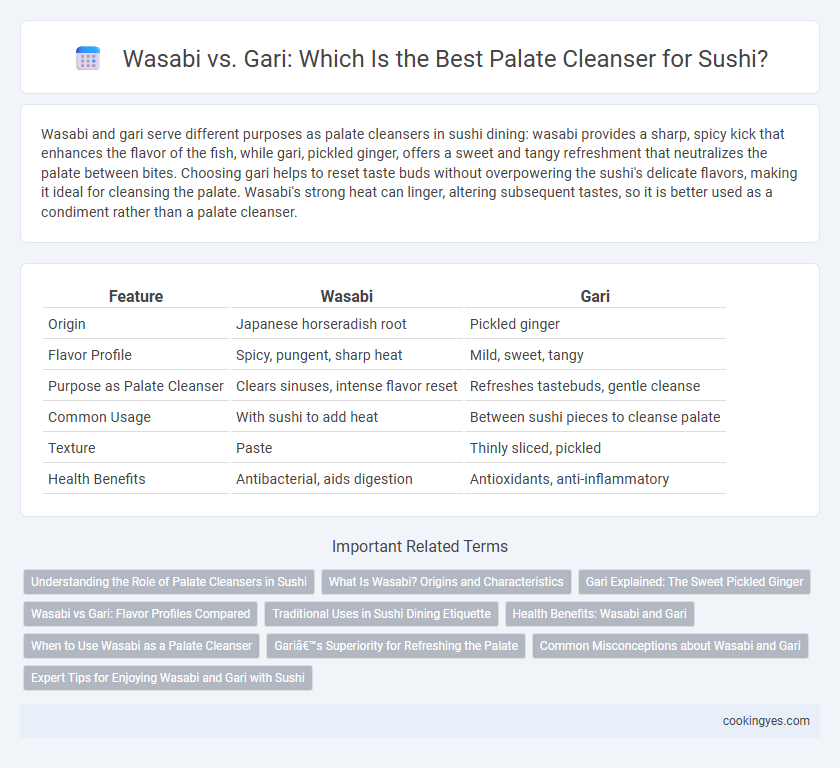Wasabi and gari serve different purposes as palate cleansers in sushi dining: wasabi provides a sharp, spicy kick that enhances the flavor of the fish, while gari, pickled ginger, offers a sweet and tangy refreshment that neutralizes the palate between bites. Choosing gari helps to reset taste buds without overpowering the sushi's delicate flavors, making it ideal for cleansing the palate. Wasabi's strong heat can linger, altering subsequent tastes, so it is better used as a condiment rather than a palate cleanser.
Table of Comparison
| Feature | Wasabi | Gari |
|---|---|---|
| Origin | Japanese horseradish root | Pickled ginger |
| Flavor Profile | Spicy, pungent, sharp heat | Mild, sweet, tangy |
| Purpose as Palate Cleanser | Clears sinuses, intense flavor reset | Refreshes tastebuds, gentle cleanse |
| Common Usage | With sushi to add heat | Between sushi pieces to cleanse palate |
| Texture | Paste | Thinly sliced, pickled |
| Health Benefits | Antibacterial, aids digestion | Antioxidants, anti-inflammatory |
Understanding the Role of Palate Cleansers in Sushi
Wasabi and gari serve distinct roles as palate cleansers in sushi, enhancing the dining experience by refreshing taste buds between bites. Wasabi provides a sharp, spicy heat that stimulates the senses and sharpens flavors, while gari, pickled ginger, offers a sweet, tangy contrast that neutralizes lingering tastes. Understanding these differences ensures proper use: wasabi is often applied directly to sushi for complementary spice, whereas gari is consumed between pieces to cleanse the palate and reset flavor perception.
What Is Wasabi? Origins and Characteristics
Wasabi, often called Japanese horseradish, originates from the Wasabia japonica plant native to Japan's mountain stream beds, prized for its sharp, pungent flavor and bright green color. Its heat is intense but short-lived, stimulating the nasal passages rather than overwhelming the tongue, which differentiates it from other spicy condiments. Authentic wasabi is rare and expensive, commonly replaced by a mixture of horseradish, mustard, and green food coloring in many sushi establishments.
Gari Explained: The Sweet Pickled Ginger
Gari, the sweet pickled ginger served with sushi, acts as an effective palate cleanser by refreshing the taste buds and preparing them for the next bite. Its subtle sweetness and tangy flavor contrast with sushi's savory elements, enhancing the overall dining experience without overpowering the delicate tastes. Unlike wasabi, which delivers a sharp, spicy kick, gari gently balances flavors and aids digestion, making it the preferred choice for resetting the palate.
Wasabi vs Gari: Flavor Profiles Compared
Wasabi features a sharp, pungent heat that quickly dissipates, stimulating the nasal passages and enhancing the flavors of sushi without overpowering them. Gari, or pickled ginger, offers a sweet, tangy, and slightly spicy profile that cleanses the palate by neutralizing lingering tastes between bites. Choosing wasabi or gari depends on whether you prefer a spicy kick that heightens taste or a mild, refreshing cleanse that resets the palate.
Traditional Uses in Sushi Dining Etiquette
Wasabi and gari serve distinct roles as palate cleansers in traditional sushi dining etiquette. Wasabi, made from Japanese horseradish, is applied directly to sushi to enhance flavor and provide a subtle heat that complements raw fish. Gari, pickled ginger, is consumed between different sushi pieces to neutralize flavors and refresh the palate, preventing taste overlap and allowing diners to fully appreciate each unique sushi offering.
Health Benefits: Wasabi and Gari
Wasabi contains potent antimicrobial properties and antioxidants that support immune health and digestion, making it a natural aid against foodborne bacteria in sushi. Gari, or pickled ginger, offers anti-inflammatory effects and promotes digestion by stimulating saliva and enzymatic activity, which helps cleanse the palate between sushi bites. Both wasabi and gari provide unique health benefits, with wasabi enhancing food safety and gari supporting gut health and flavor separation.
When to Use Wasabi as a Palate Cleanser
Use wasabi as a palate cleanser when seeking a sharp, spicy contrast between sushi bites to invigorate the taste buds. Its strong pungency helps clear the palate quickly, preparing the mouth for more complex flavors in subsequent pieces. Wasabi pairs best with rich, fatty fish like toro or salmon, enhancing the sushi experience through its intense heat.
Gari’s Superiority for Refreshing the Palate
Gari, the pickled ginger served with sushi, excels as a palate cleanser due to its mild sweetness and subtle acidity, which refresh the taste buds without overpowering the delicate flavors of fish. Unlike wasabi, which is pungent and intensely spicy, gari provides a gentle contrast that resets the palate, enhancing the enjoyment of each bite. The natural enzymes in gari also aid digestion, making it the superior choice for maintaining flavor clarity between sushi pieces.
Common Misconceptions about Wasabi and Gari
Wasabi is often mistaken solely as a palate cleanser, but its primary role is to enhance sushi flavor with its sharp heat rather than neutralize taste. Gari, or pickled ginger, is the true palate cleanser, designed to refresh the palate between different sushi types without overpowering flavors. Many assume wasabi's spiciness cleanses the palate, but its intensity can actually linger, obscuring subtle tastes that gari effectively clears away.
Expert Tips for Enjoying Wasabi and Gari with Sushi
Wasabi offers a sharp, spicy heat that enhances the natural flavors of sushi, while gari (pickled ginger) provides a sweet, tangy contrast that refreshes the palate between bites. Experts recommend using a small dab of wasabi directly on sushi to intensify the umami without overpowering the fish, and cleansing the palate with gari to prevent flavor overlap. Balancing wasabi and gari allows sushi enthusiasts to experience distinct taste profiles and maintain a harmonious dining experience.
Wasabi vs Gari for palate cleansers Infographic

 cookingyes.com
cookingyes.com